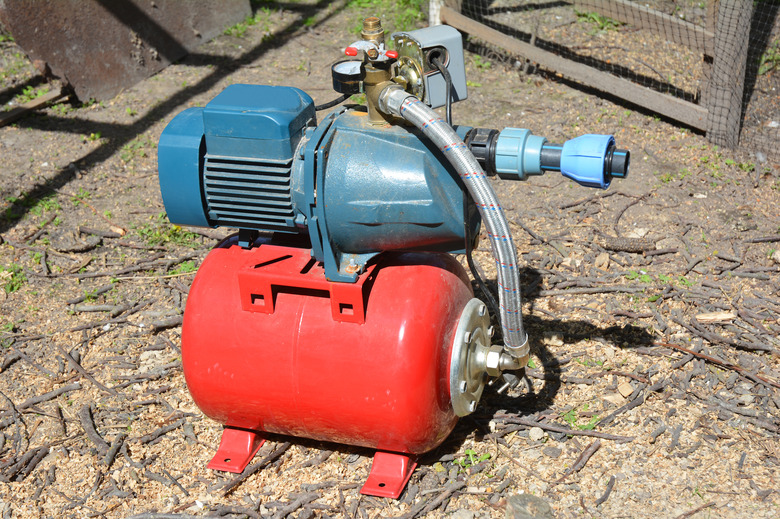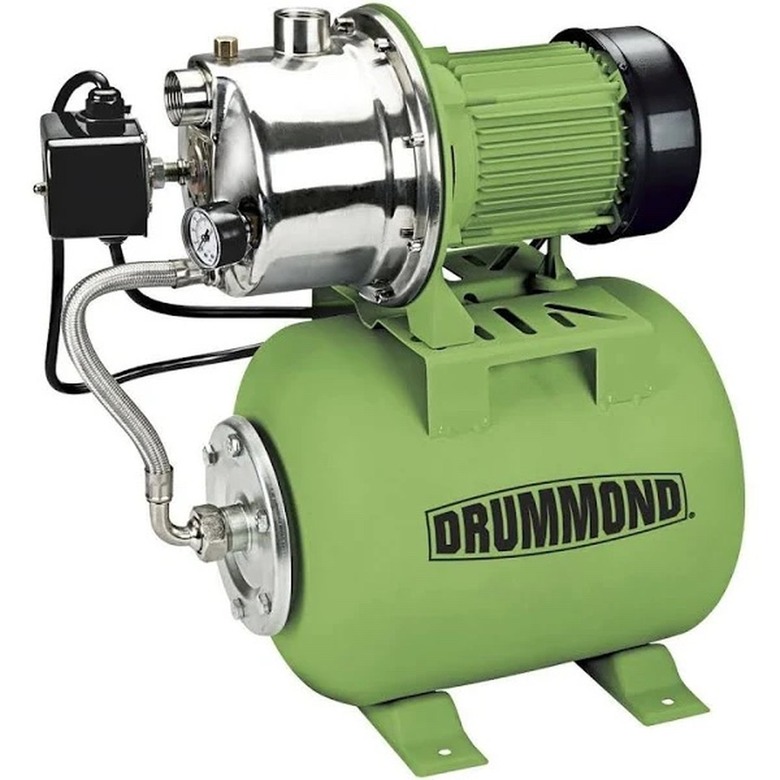A Beginner's Guide To Well Pumps
Some 13 million American households get water from a well and depend on a well pump, so the technology is well established. That's good news for you if you're moving into a new rural home or planning on building a new home on vacant land in the country.
The water pump is, of course, an essential component of the delivery system for well water, but it isn't the only one. Establishing a well is no small undertaking, and you'll be working with a well service company that will help you with the planning and the necessary permits and help you select the proper equipment. Even though you'll have help establishing your well, it's still a good idea to have an understanding of the components of your new system because it will be up to you to maintain it. The same goes for homeowners moving into new homes that already have wells.
The main determinant of the type of well pump and the components your well pump system needs is the depth of the well. If the property is on low-lying ground, the water table may be only a few feet below the surface, and you will have a shallow well. If the property is at elevation, the water table could be several hundred feet below the surface, in which case you'll have a deep well. The recommended pumps for shallow, moderately deep, and deep wells operate in different ways.
Types of Well Pumps
Types of Well Pumps
The fact that shallow well pumps operate on a different principle than deep well pumps makes a difference to the entire well system. Shallow well pumps can develop enough pressure to charge a pressure tank, but systems with deep well pumps usually need to have a nonpressurized holding tank from which water must be transferred under pressure to the pressure tank.
Shallow well pumps may be centrifugal or jet pumps. A centrifugal pump has impellers that develop suction to pull water out of the well. The process depends on atmospheric air pressure, which pushes water into the vacuum created by the impellers, and it only works for wells with a maximum depth of 25 feet. A jet pump, on the other hand, has an impeller that circulates pressurized water through a valve — called a jet — that narrows the stream and squirts the water through a pipe that extends into the well water. The jet increases the velocity of the water passing through it while reducing the pressure, and this combination creates a suction that pulls water out of the well more powerfully than a centrifugal pump is able to do.
A jet pump can be used for wells up to 100 feet deep and uses the same principle employed in inexpensive garden hose water pumps. When you attach a garden hose pump to a faucet and turn on the water, the flow of water through the pump creates enough suction to pull water out of a ditch or a hole in the yard. To pull water out of a well, a jet pump needs two pipes inserted into the well. One contains the jet and the "driving water," and one transports the water that comes out of the well to the pressure tank.
Centrifugal and jet pumps and the piping attached to them need to be primed, which means they need to be filled with water and purged of air, or they won't work. The pump itself is above ground and accessible — often located in a well house — so you can service the pump motor if something goes wrong. The jet for a jet pump is positioned inside the well, and the system has a check valve known as a foot valve, which is also inside the well casing. This valve prevents water from flowing back toward the jet. If either the jet or foot valve fails, the pump won't work, and you have to pull them out of the well to service them.
Deep well pumps are submersible and work by pushing water up from the bottom of the well to the top rather than drawing out the water by suction. They don't develop enough pressure to charge a pressure tank, so the water usually goes into a storage tank. This type of system needs an additional pressure pump to transfer water under pressure from the storage tank to the pressure tank.
Unlike a centrifugal or jet pump, a submersible pump has to be under water to work. It's tubular to fit inside the 3- or 4-inch pipe that fits inside the well casing, and it sits at the bottom of the well below the surface of the water table. The pump's electric motor and impellers are hermetically sealed inside the pump housing. Submersible pumps tend to last longer and need less maintenance than jet pumps, but when a submersible pump does need servicing, you have to pull it out of the well. You can do this yourself, but it's best to call a service pro.
Sizing Your Well Pump
Sizing Your Well Pump
The optimum size of your well pump depends not only on the depth of the well but also on how far the well is from the house and how much water you need. A standard 1/2 horsepower jet pump or pressure pump that can deliver water at a rate of 6 to 12 gallons per minute is usually adequate for a single-family home with one or two bathrooms, a washing machine, and a dishwasher. A property with an extensive irrigation system probably needs more water and a bigger pump. Moreover, a pump transferring water from a well several hundred feet away from the house needs to have more power than one transferring water only 50 feet.
Well pumps are available in sizes from 1/2 hp to 5 hp. Because so many variables are involved in sizing, it's best to consult with a well service professional. Cost shouldn't be a major factor; most models retail for $300 to $500, and even a very powerful one usually costs less than $1,000.
Other Components of Well Systems
Other Components of Well Systems
If you follow the path of the water from the well to the faucets in the house, you'll encounter the other components of the well system.
- Pitless adapter: This is the common and slightly strange name for the fitting that connects the well casing to the plumbing pipes. Its purposes are to prevent leaks, maintain sanitation, and prevent the water from freezing. Previously, the best way to prevent freezing was to dig a pit below the frost line for the water pipe junction. Since this allowed surface water into the well, potentially contaminating it, this practice has been abandoned in favor of frost-proof, watertight pitless adapters installed below the frost line.
- Storage tank: If you have a deep well submersible pump, it will deposit water into a nonpressurized plastic or stainless steel storage tank. Inside the tank is a mechanical or electrical float switch that switches on the pump when the water falls below a preset level. A system with a storage tank usually has a pressure pump (or booster pump) to transfer water from the storage tank to the pressure tank. This additional pump, which is similar to a shallow well pump, might not be necessary if the storage tank can be installed at a high enough elevation for gravity to pressurize the water.
- Pressure tank: All well systems have a pressure tank that contains two compartments separated by a bladder or diaphragm. When pressurized water is pumped into the tank either by the well pump or by an auxiliary pressure pump, the air compresses until there is enough water pressure to feed the house. The air pressure pushes the water out of the tank into the plumbing system.
- Pressure switch: A small, rectangular box with incoming and outgoing electrical wires, the pressure switch is the component that regulates water pressure. It monitors the pressure in the tank and controls the pump that pressurizes the tank. It switches on the pump when the pressure drops to its cut-in value, which is usually between 30 and 40 psi, and it switches off the pump at its cut-out value, which is usually between 50 and 60 psi.
Well Pump Maintenance
Well Pump Maintenance
Malfunctions with well water systems that result in low water pressure, complete loss of pressure, or contaminated water may be caused by the well pump or any of the components of the pump system. Homeowners can repair some of these, but those originating in the well itself, including any that affect the components inside the well casing, require the services of a well pump service professional.
Some problems that homeowners can address themselves include:
- Loss of prime: Well pumps provide water, and it's water that makes a well pump work. If a shallow well pump runs out of water, you have to refill it. This is called priming the pump, and you may have to do it after a power outage or some other incident that empties the pump. Because a submersible pump lives under water, it never needs priming.
- Loss of water pressure: This can happen for many reasons, the most serious being that the well is running dry. In many cases, the problem is a loss of power to the pressure switch caused by a tripped circuit breaker or some other electrical issue. If the switch is old and the terminals are corroded, it's a simple DIY job to replace it.
- Loss of water: The storage tank in a deep well system may run dry if the float switch malfunctions. Homeowners can often fix this themselves. Sometimes, all it takes is to manually adjust the switch.
- Large electrical bill: When the bladder in the pressure tank ruptures and water gets into the air chamber, the tank can't maintain pressure, and the pump cycles on more frequently than it should. To resolve this, you usually have to replace the pressure tank. It's a big job, but it's one you can do yourself.

